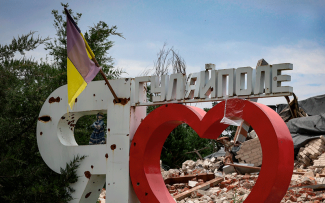The Russians are flanking Huliaipole. Day 1371 of the war

![]()
The Russians continue their offensive in the Zaporizhzhia region, seeking to close Huliaipole in operational encirclement. They have managed to take control of the village of Zatyshshia, about 2.5 km from the northern outskirts of the city. In recent days, the defence has been hampered by Russian forces cutting off one of the key logistical routes leading to Huliaipole from Pokrovske, located to the north. To this end, the invaders have approached Radisne and Danylivka, which lie on this route and, according to some reports, they already occupy them. In this way, they are trying to synchronise their offensive towards Huliaipole with an attack on Pokrovske in Dnipropetrovsk Oblast.
South of Zaporizhzhia, Russian forces are advancing on Prymorske. Moving in small groups, they are trying to take advantage of the favourable terrain along the dry Kakhovka Reservoir and the summer resort areas to the east of it. They are trying to bypass Stepnohirsk from the west and break through to Hryhorivka to the north.
The situation in Pokrovsk remains difficult. Defenders are holding their positions in the northern part of the city, trying to block enemy troops from crossing the railway line running there and to prevent Myrnohrad from being completely surrounded. The Ukrainians are thought to have withdrawn from the southern part of the city with fighting continuing for the towns of Svitle and Rivne between Pokrovsk and Myrnohrad. The Russian offensive is still being held back by ongoing fighting for Krasnyi Lyman, north of the conurbation. However, Russia has made progress northwest of Pokrovsk, near the village of Hryshyne.
Contrary to Moscow’s statements, Russia has still not managed to take complete control of Kupiansk. In fact, fighting is still ongoing in the south-eastern areas of the town and in the Kurylivka area east of Kupiansk-Vuzlovyi, where Russia is trying to gain a foothold in order to encircle Kupiansk from the south.
![]()
Russia continues its air strikes on Ukrainian energy infrastructure and civilian facilities, including residential buildings. On the night of 18–19 November, there was a massive missile and drone strike on the western regions of the country, including Ternopil, where Kh-101 cruise missiles damaged two residential blocks and heating network facilities. Thirty-four people (including six children) were killed and more than 90 were injured. In connection with this event, Days of Mourning were declared in the city from 19 to 21 November.
On the same night, Russia carried out air strikes on energy infrastructure facilities in the Kharkiv, Chernihiv, Dnipropetrovsk, Lviv, Ivano-Frankivsk, Cherkasy, and Donetsk oblasts. Damage was also reported in Lviv, where a logistics centre on the outskirts of the city was hit. In Kharkiv, residential buildings and a medical facility were targeted. The Russians targeted the city again on 21 and 23 November. Several residential buildings were destroyed as a result of the use of kamikaze drones and aerial bombs. Four people were killed and at least 13 were injured in the attack.
On 20 November, Russia attacked Dnipro, where it hit, among other things, a food warehouse belonging to the UN World Food Programme. On the same day, they used artillery, rockets and drones to strike critical infrastructure, a medical facility and multi-storey residential buildings in Kherson, killing at least one person and injuring eight. The city was then targeted for another two days. On 20 and 22 November, the invaders shelled Zaporizhzhia, killing five people and injuring several others.
On the night of 21 to 22 November, a Russian drone was used to attack the border crossing in Orlivka on the Ukrainian-Romanian border. The infrastructure of the ferry crossing over the Danube was damaged, resulting in the temporary suspension of transport traffic. Odesa Oblast and the region’s port infrastructure were the target of air strikes for the next three days – on 24 November, a fire broke out on one of the civilian ships near the port of Odesa. Energy and industrial facilities were also attacked.
On 24 November, Russian drones struck Chernihiv, completely destroying one of the residential buildings, as well as the energy infrastructure of the Donetsk, Kharkiv, Chernihiv, and Dnipropetrovsk oblasts. As a result of the attack on the latter, more than 60,000 customers are completely without electricity, and as a result of the strike on Kharkiv, approximately 10,000. The attacks on 25 November deprived approximately 40,000 residents of Kyiv Oblast, 20,000 in Odesa Oblast and 13,000 in Chernihiv Oblast of electricity. All regions are subject to scheduled power outages, and most also have power restrictions for industrial consumers and businesses.
On the night of 24–25 November, another massive attack was carried out on the Ukrainian capital. The air raid targeted energy facilities and residential buildings, including multi-storey buildings. Six people were killed and 12 were injured as a result of the strikes. Heat supplies were temporarily restricted in various parts of the city.
In total, according to estimates by the Air Force of the Armed Forces of Ukraine (AFU), between 19 and 25 November, hostile forces carried out air strikes using 1,577 unmanned aerial vehicles (of which 905 were “Shaheds”), 40 Kh-101 cruise missiles, four Kh-47M2 Kinzhal missiles, 15 Kalibr cruise missiles, four Iskander-M ballistic missiles and seven Iskander-K cruise missiles. All missile strike assets and almost a third of unmanned aerial vehicles were used on the night of 19–20 November (476 drones were used) and 24–25 November (464). In total, Ukrainian air defences reportedly destroyed 1,364 attack drones, one Kinzhal missile, five Iskander-K missiles, 12 Kalibr missiles, three Iskander-M missiles and 34 Kh-101 missiles.
![]()
On 23 November, Ukrainian attack drones struck a power plant in the town of Shatura in Moscow Oblast. The Russian Ministry of Defence reported that two unmanned aerial vehicles had been shot down while the regional authorities confirmed the strikes, which caused a fire (the facility in Shatura supplies electricity and heat to towns in Moscow Oblast).
On the night of 24–25 November, SZU unmanned aerial vehicles are thought to have attacked the military airport in Taganrog. According to unconfirmed reports, one of the aircraft (allegedly an A-60) was destroyed. The airport is the main test base of the Taganrog Aviation Scientific and Technical Complex, which specialises in the production, modernisation and repair of assault aircraft and special-purpose aviation complexes.
![]()
On 8 November, the United States approved the possible sale to Kyiv of a package of technical support and modernisation of Patriot air defence system launchers for a maximum price of $105 million. The modernisation will include the adaptation of M901 launchers, which can only fire PAC-2 missiles, to the M903 version, which will enable the use of PAC-3 missiles.
On the same day, the CEO of Rheinmetall announced that his company had delivered all four Skynex anti-aircraft artillery systems previously declared by the German government to Ukraine. Furthermore, by the end of the month, it will deliver the first (of an undisclosed number) Skyranger 35 self-propelled anti-aircraft systems mounted on a Leopard 1 chassis, which is financed from interest on frozen Russian assets. The order for this system was placed by one of the EU countries.
On 18 November, during President Volodymyr Zelensky’s visit to Madrid, Prime Minister Pedro Sánchez announced that his country would provide €615 million in military support to Kyiv. Of this amount, €300 million will be allocated to direct donations of military equipment, €215 million to purchases of European weapons under the SAFE programme, and €100 million to the purchase of American arms under the Prioritised Ukraine Requirements List (PURL) mechanism.
On 20 November, Foreign Minister Radosław Sikorski announced that Poland would allocate $100 million to Ukraine under the PURL. On the same day, Canada announced the completion of the previously announced deliveries of M113 armoured personnel carriers and declared that it would deliver 25 more in the near future, along with 125 AIM-7 Sparrow anti-aircraft missiles.
![]()
On 18 November, the General Staff of the Armed Forces of Ukraine announced the use of American ATACMS missile systems to destroy military targets on Russian territory. The statement did not specify the location of the target or the time of the attack. This information means that these missiles were used for the first time since late spring. In August, the American press reported that the Pentagon had been blocking Ukrainians using ATACMS for attacks on Russian territory for several months. Tuesday’s statement by Ukraine may therefore signal a change in the policy of the US Department of War.
On 22 November, the Special Operations Forces press office reported that, during a drone attack on Russia, the Ukrainian armed forces shot down an enemy helicopter for the first time using a long-range unmanned aerial vehicle. A Mi-8 helicopter was reportedly hit near the village of Kuteynikovo in Rostov Oblast.
The Ukrainian Ministry of Defence announced in a statement on 24 November that 100,000 FPV drones had been delivered to the army via the Ukrainian DOT-Chain Defence platform, of which almost a third were drones controlled by fibre optic cables. DOT-Chain Defence is a special digital platform launched in June this year, through which brigades fighting in key areas can directly place orders for FPV drones from selected suppliers. It was emphasised that the use of the platform has significantly reduced bureaucracy, enabling the fast and efficient delivery of equipment to the front line. The advantage of the programme is that it delivers specific models to units which have themselves chosen the type of FPV drones they need for their operations. On the platform, formation commanders can choose from over 180 models of FPV unmanned aerial vehicles supplied by 40 companies. According to the ministry’s estimates, the average delivery time for drones using the DOT-Chain service is seven days, with the Defence Procurement Agency of the Ministry of Defence of Ukraine (MOD-U) responsible for payments, signing contracts and logistics.
The Council of Ministers has adopted an experimental procedure enabling the creation of air defence groups for Ukrainian critical infrastructure facilities. The project will initially cover entities responsible for the functioning of the energy, communications, transport and water supply sectors. They will be able to purchase or receive air defence equipment in accordance with the decisions of the military command or procedures agreed with the D-U. The groups will consist of employees ofcompanies who have been vetted by the Security Service of Ukraine. The groups will operate on the orders of the military command, and their leaders will be given access to a digital air defence management system.
The number of Ukrainian soldiers who, after leaving their units without permission, have declared their return to service is growing. Andriy Illienko, an officer of the Rubizh National Guard brigade, stated on 21 November that at the end of August this year, the Verkhovna Rada de facto introduced an amnesty forthese acts, but each case requires a positive court decision. A solution to streamline the process would be for military units to accept returning soldiers without court proceedings. The growing problem of abandoning service or desertion stems from chaotic or illogical orders generating heavy casualties, personal conflicts with commanders, and the ignoring of transfer requests. In October alone, more than 20,000 soldiers left military units without permission.
![]()
On 19 November, the Ukrainian Coordination Staff for Prisoners of War reported that between February 2022 and July 2025, Russia forcibly mobilised 46,327 Ukrainian citizens from the occupied territories, including over 35,000 in Crimea alone.
Ukrainian military intelligence has identified over 18,000 foreigners from 128 countries who are fighting or have fought against Ukraine as part of the Russian Armed Forces. At least 3,388 foreign mercenaries have been killed during the hostilities. Ukraine is currently holding prisoners of war from 37 countries who fought in the Russian army – Russia is not seeking their exchange, except in the case of North Korean citizens.






